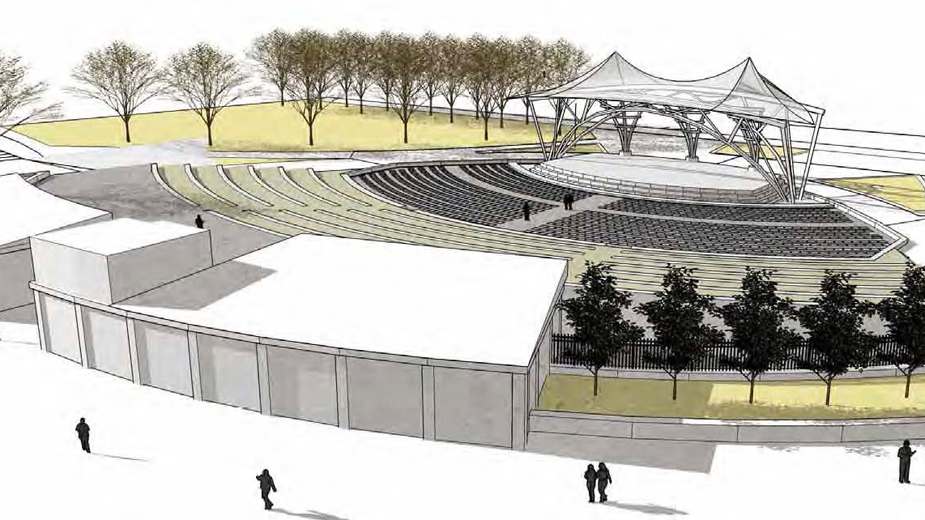$6M Amphitheater Project Begins to Take Shape
YOUNGSTOWN, Ohio – City Council tonight will hear from representatives of MKSK, the Columbus landscape architecture firm the city engaged last year to develop a master plan for the proposed amphitheater and riverfront park on the former Wean building property near the Covelli Centre.
At tonight’s meeting, council members will learn the status of work already under way and what resources are needed to move the project forward, Mayor John McNally said.
“In general, we’re going to be presenting the concept plan, which a lot of them already participated in to date,” Finance Director David Bozanich said. “We’re going to let them know that additional legislation is required to site the facility, to let the engineering contracts for the design work and then fund the facility. That’s all forthcoming as part of the process.’
Construction of the open-air amphitheater, which would have terraced seating for 3,250 patrons, and related structures likely will cost around $6 million, Bozanich said.
“We don’t envision a whole lot, if any, permanent seating,” he said. Rather than a band shell-type structure, the amphitheater would have more of a canopy-type cover for the main stage.
“Once you put seating in place, you can’t use the space for anything else except seating,” the finance director added. “This just gives us more opportunity for more open spaces to be use for a variety of purposes.”
Other objectives of MKSK’s $141,000 contract include using land on either side of the Market Street bridge to create an “appealing front door” to the downtown, providing a better location for smaller festivals, and strengthening linkages to Youngstown State University via Phelps and Hazel streets.
According to the proposal, the first phase of the project, on the west side of the Market Street bridge, would encompass construction of the amphitheater and related structures, the promenade, entry plaza, utility connections and VIP parking. The second phase, on the west side of the bridge, includes earthwork seeding and planting, trails and paths, parking improvements for the Covelli Centre and an in-line hockey park.
Features of the project also would include splash pads to create a “mini-waterpark” on the site, McNally said.
Upgrades to Phelps between Commerce and Federal would model it on East 4th Street in Cleveland, “where basically at certain points of time you can shut the whole block down and make it a mini plaza,” McNally said.
Gateways for both Hazel and Phelps are being considered similar to that of Acorn Alley in Kent. Other aspects of the project include establishing an entertainment district bordered by Phelps, Hazel, Commerce and Federal streets.
Already underway is encapsulating the former Wean site, McNally said. The CleanOhio program is covering about $1.2 million of the $1.7 project
McNally said he doesn’t anticipate any general fund money to be used for the project, but how much of the funding will come from naming rights opportunities is still to be determined.
The city officials are optimistic about prospects for naming rights deals. Naming opportunities include community spaces along the boulevard, the waterpark and even renaming of Hazel Street.
“We’re very pleased with the reception we’ve gotten so far,” Bozanich said. “The history of what we’ve accomplished with the Covelli Centre has led to a response that’s been much more positive than the original response we received for the arena.”
With these discussions under way, the city could be in the range of covering half of new project’s costs, with additional site dollars available though the city’s enterprise funds.
“I’m not saying that 50% number is a lock-in number,” Bozanich said. “We believe that’s a range, but it could go higher.”
The work that needs to be done on site, including the dirt compaction and relocation of an 84-inch sewer line, probably gives the city another nine months to a year for fund-raising to take place, McNally said.
“The one thing I don’t think we envisioned was the sewer work that has to be done, That 84-inch line, I think, is the oldest sewer line in the city and probably one of the largest,” McNally said. The relocation will cost in the neighborhood of $5 million. The city let a contract for that work last week.
“That needs to be moved before we can construct anything on this site. The last thing I want to do is to have the sewer start to collapse on a site as it’s built,” the mayor remarked.
Pictured at top: Rendering of the project.
Copyright 2024 The Business Journal, Youngstown, Ohio.



